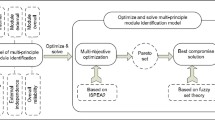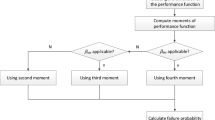Abstract
Against the sweeping trend of mass customization, the importance of product platform design is becoming increasingly recognized by the manufacturers. Module design is the foundation of product platform design, and module partition determines the effectiveness of module design. Traditionally, the vast majority of existing module partition methods ignored the design factor of customer preferences. This study proposes to employ the basic principles of robust design to make the module partition schemes less sensitive to the dynamically changing customer preferences by considering them as a noise factor. A criterion function and a noise function are each established based on the component-component correlation matrix and component-function contribution matrix, respectively. The criterion and noise functions, when combined, lead to a unique multi-objective optimization problem. Furthermore, an improved Pareto archive particle swarm optimization (PAPSO) algorithm is introduced to solve the multi-objective optimization problem in order to prevent the premature selections of non-optimal solutions. A case study is presented to showcase how the proposed new method is followed to conduct the module partition on an electric-traction drum shearer. The improved algorithm demonstrates highly competitive performance in comparison to the existing multi-objective optimization algorithms.
Similar content being viewed by others
References
Tchertchian N, Millet D, Pialot O (2013) Modifying module boundaries to design remanufacturable products: the modular grouping explorer tool. J Eng Des 24(8):546–574
FJ Emmatty, S. P. Sarmah. (2012). Modular product development through platform-based design and DFMA. J Eng Des 23(9):696-714.
Umeda Y, Fukushige S, Tonoike K (2008) Product modularity for life cycle design. J. CIRP Annals: Manufacturing Technology, 57, 13-16.
Simpson TW, D’souza B (2006) Assessing variable levels of platform commonality within a product family using a multi-objective genetic algorithm. 9th AIAA/ISSMO symposium on multidisciplinary analysis and optimization. Atlanta 9:1–10
Moon SK, Park KJ, Simpson TW (2014) Platform design variable identification for a product family using multi-objective particle swarm optimization. Res Eng Des 25:95–108
Algeddawy T, Elmaraghy H (2013) Optimum granularity level of modular product design architecture. CIRP Ann Manuf Technol 62:151–154
Özacar T, Öztürk O, Ünalir MO (2011) ANEMONE: An environment for modular ontology development. Data Knowl Eng 70:504–526
Li ZK, Cheng ZH, Feng YX et al (2013) An integrated method for flexible platform modular architecture design. J Eng Des 24:25–44
Cheng J, Liu Z, Wu Z et al (2016) Direct optimization of uncertain structures based on degree of interval constraint violation. Comput Struct 164:83–94
Wang R (2009) Based on the axiomatic design and the integrated module partition method of fuzzy tree graph. Journal of agricultural machinery 40(4):179–183
Xiao C (2009) Complex product module partition method based on the function flow study. Mechanical design and manufacturing 12:249–251
Gao S (2005) Based on function module partition method in flow model and case study. Machine with hydraulic 9:22–23
Pan S (2003) Mass customization production mode of module partition method research. Journal of mechanical engineering 39(7):1–6
Xiao R, Cheng X (2016) A systematic approach to coupling disposal of product family design (part 1): methodology. Procedia CIRP 53:21–28
Rathod V, Yadav OP, Rathore A et al (2013) Optimizing reliability-based robust design model using multi-objective genetic algorithm. Comput Ind Eng 66:301–310
Gremyr I, Siva V, Raharjo H et al (2014) Adapting the robust design methodology to support sustainable product development. J Clean Prod 79:231–238
Zhengyu L (2005) Research on evaluation method of module division scheme. Construction machinery 36(5):24–26
Guo W, Liu G, Zhang L (2010) Research on product green module partition method for full life cycle. Journal of Hefei University of Technology 33(10):1441–1445
Wang H, Wang J, Sun B (2005) Optimization design of modular product family based on core platform. Comput Integr Manuf Syst 11(2):162–167
Salil D, Bopaya B, Lovell MR (2012) Material and process selection in product design using decision-making technique (AHP). European Journal of Industrial Engineering 43:322–346
Ehsan T, Maryam M (2011) A novel method in fuzzy data clustering based on chaotic PSO. Internet technology and secured transactions, pp. 335–340
Alvarez-Benitez JE, Everson RM, Fieldsend JE (2005) A MOPSO algorithm based exclusively on pareto dominance concepts, evolutionary multi-criterion optimization. Lect Notes Comput Sci 3410:459–473
Su S, Yu H, Wu Z, Tian W (2014) A distributed coevolutionary algorithm for multiobjective hybrid flowshop scheduling problems. Int J Adv Manuf Technol 70:477–494
Cheng J, Liu Z, Tan J (2013) Multiobjective optimization of injection molding parameters based on soft computing and variable complexity method. Int J Adv Manuf Technol 66:907–916
Jongbin I, Jungsun P (2013) Stochastic structural optimization using particle swarm optimization, surrogate models and Bayesian statistics. Chin J Aeronaut 01:112–121
Wu X (2011) Uniform search particle swarm optimization (PSO) algorithm. Electronic journals 39(6):1261–1266
Pluhacek M, Senkerik R, Zelinka I et al (2013) New adaptive approach for chaos PSO algorithm driven alternately by two different chaotic maps—an initial study. J. Advances in Intelligent Systems and Computing 210:77–87
Feng YX, Zheng B, Li ZK (2010) Exploratory study of sorting particle swarm optimizer for multiobjective design optimization. J. Mathematical and Computer Modeling 52:1966–1975
An WG (2007) Interactive multi-objective optimization design for the pylon structure of an airplane. Chin J Aeronaut 06:524–528
Fan WH, Xu HY, Xu X (2009) Simulation on vehicle routing problems in logistics distribution. J COMPEL - The international journal for computation and mathematics in electrical and electronic engineering 28:1516–1531
Zitzler E, Laumanns M, Thiele L (2001) SPEA2: improving the performance of the strength Pareto evolutionary algorithm, technical report 103. Zurich, Computer Engineering and Communication Networks Lab (TLK), Swiss Federal Institute of Technology (ETH)
Hart E, Timmis J (2005) Application areas of AIS: the past, the present and the future. Proc 4th Inter Conf Arti Immune Sys, ICARIS 2005, Springer, Lect Notes in Comp Sci 3627:483–497
Author information
Authors and Affiliations
Corresponding author
Rights and permissions
About this article
Cite this article
Wei, W., Liang, H., Wuest, T. et al. A new module partition method based on the criterion and noise functions of robust design. Int J Adv Manuf Technol 94, 3275–3285 (2018). https://doi.org/10.1007/s00170-016-9797-4
Received:
Accepted:
Published:
Issue Date:
DOI: https://doi.org/10.1007/s00170-016-9797-4




